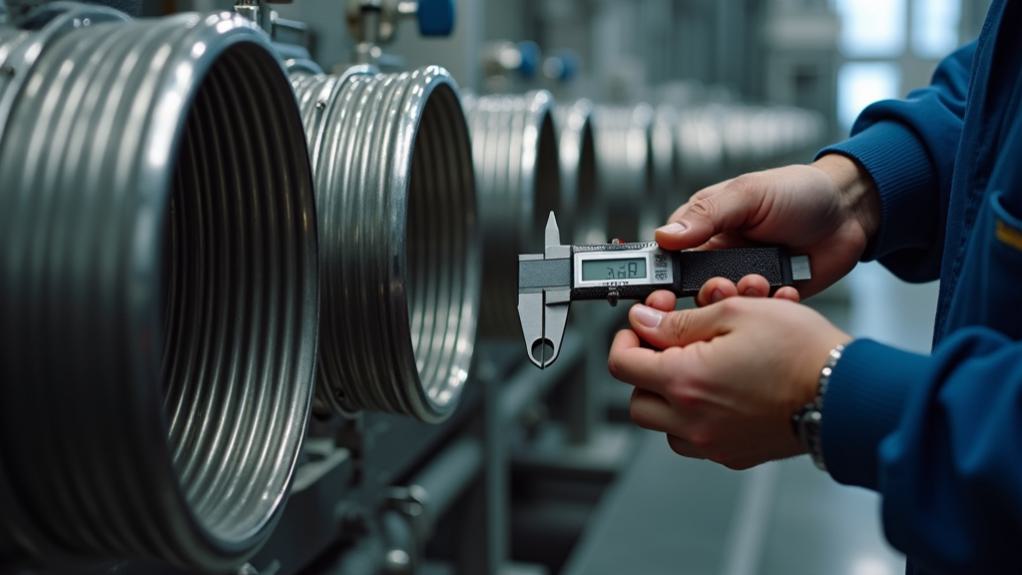
To properly size metal expansion joints, you'll need to follow these five key tips: First, determine the required movement range, factoring in all potential sources of displacement and adding safety margins. Second, calculate pressure and temperature limits, considering both normal and surge conditions. Third, assess flow rates and velocities to prevent erosion and turbulence issues. Fourth, evaluate environmental factors that may impact joint performance, including temperature fluctuations and chemical exposure. Finally, choose appropriate materials and designs that match your specific application needs. By considering these factors, you'll guarantee peak expansion joint performance and system longevity.
Determine Required Movement Range
Determining the required movement range is the essential first step in sizing metal expansion joints.
You'll need to calculate the total expected movement in all directions - axial, lateral, and angular. Take into account thermal expansion and contraction, equipment vibration, and potential settling or shifting of connected structures. Consult engineering drawings, specifications, and local building codes to gather necessary data.
You should factor in safety margins to account for unexpected movements or installation variations. Typically, add 10-20% to your calculated movement range.
Don't forget to take into account extreme temperature fluctuations and seismic activity if applicable to your location.
Proper installation techniques play a vital role in ensuring your expansion joint performs within its designed movement range.
Follow manufacturer guidelines closely and use appropriate tools and methods during installation.
Regular maintenance practices, including periodic inspections and measurements, help verify that the joint continues to operate within its specified range.
Calculate Pressure and Temperature Limits
After determining the movement range, you'll need to calculate the pressure and temperature limits for your metal expansion joint. These limits are critical for guaranteeing safe and effective operation within your system.
Start by identifying the maximum pressure the joint will experience during normal operation and potential surge conditions. Factor in safety margins based on industry standards and your specific application requirements.
Next, determine the temperature range the expansion joint will be exposed to. Consider both the internal fluid temperature and any external heat sources. Remember that extreme temperatures can affect the joint's material properties and performance.
Consult manufacturer specifications and material data sheets to verify compatibility with your operating conditions.
Don't forget to account for installation techniques and maintenance practices when calculating these limits. Proper installation can notably impact the joint's ability to handle pressure and temperature fluctuations.
Regular maintenance, including inspections and adjustments, will help guarantee the joint continues to operate within its design parameters.
Consider Flow Rates and Velocities
Once you've established pressure and temperature limits, it's vital to take into account flow rates and velocities within your system. These flow characteristics directly impact the performance and longevity of your metal expansion joints.
You'll need to take into account both the average and maximum flow rates your system will experience, as well as any potential surge conditions.
Velocity considerations are important when sizing expansion joints. High velocities can lead to erosion, vibration, and excessive noise. You'll want to make certain that the expansion joint's cross-sectional area is sufficient to maintain acceptable flow velocities.
As a rule of thumb, aim for velocities below 100 feet per second for gases and 15 feet per second for liquids.
Don't forget to account for changes in flow direction. Elbows and other fittings can create turbulence and affect the expansion joint's performance.
You may need to incorporate flow straighteners or adjust the joint's placement to mitigate these effects.
Assess Environmental Factors
Environmental factors frequently play an essential role in the proper sizing of metal expansion joints.
You'll need to take into account temperature fluctuations, pressure variations, and chemical exposure in your assessment. These factors can greatly impact the joint's performance and longevity.
When evaluating temperature, account for both ambient and process temperatures. Extreme heat or cold can affect the material properties of the joint, potentially leading to premature failure.
Pressure considerations should include both internal system pressure and external environmental pressures.
Chemical exposure is vital, as corrosive substances can degrade the joint material over time.
Your installation techniques and maintenance practices should also factor into your environmental assessment. Proper installation can mitigate environmental stressors, while regular maintenance can help identify potential issues before they become critical.
Examine the joint's location within your system. Is it exposed to weather elements or protected indoors?
Will it be subject to vibration or seismic activity? These factors can influence your sizing decisions and material selections.
Choose Appropriate Materials and Design
In light of your environmental assessment, selecting appropriate materials and design for your metal expansion joint is essential. You'll need to take into account material compatibility with both the system's contents and external conditions. Common materials include stainless steel, carbon steel, and specialty alloys, each offering unique properties suited to different environments.
When choosing joint configurations, you must analyze the expected movements and pressures. Single and multi-ply bellows, gimbal joints, and sliding joints are among the options available to you. Each configuration has its strengths and limitations, so you'll want to match them carefully to your specific application.
Reflect on the longevity and maintenance requirements of different materials and designs. You'll find that some combinations offer superior corrosion resistance or fatigue life, which may be critical in your industry.
Don't overlook the importance of proper sealing elements and gaskets, as these play an essential role in maintaining system integrity.
In Summary
You've now got the key considerations for sizing metal expansion joints. By determining movement ranges, calculating pressure and temperature limits, factoring in flow rates, evaluating environmental conditions, and selecting suitable materials and designs, you'll guarantee peak performance. Remember, precise sizing is critical for preventing failures and maximizing joint longevity. Always consult manufacturer specifications and industry standards when making final selections. Regularly review and update your sizing calculations as system parameters change over time.
© Copyright 2024. All RIghts Reserved
